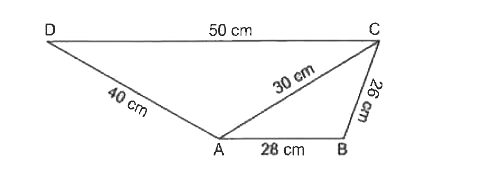Let ABCD be a quadrilateral. Let the diagonals AC and BD meet at O. Let the perpendicular drawn from A to CD meet CD at E. Further, AO:OC=BO:OD, AB = 30 cm, CD = 40 cm and the area of the quadrilateral ABCD is 1050 cm2.
What is BE equal to?
30 cm
30√2 cm
30√3 cm
None of the above
To find the length of BE in the quadrilateral ABCD, we will follow these steps:
Step 1: Understand the given information
We have a quadrilateral ABCD with:
- Diagonals AC and BD intersecting at point O.
- A perpendicular AE drawn from point A to line CD.
- Ratios: AO:OC = BO:OD.
- Lengths: AB = 30 cm, CD = 40 cm.
- Area of quadrilateral ABCD = 1050 cm².
Step 2: Set up the ratio of segments
Since AO:OC = BO:OD, we can express this as:
- Let AO = 3x and OC = 4x (since the ratio is 3:4).
- Let BO = 3y and OD = 4y.
Step 3: Establish parallel lines
From the information given, we can conclude that lines AB and CD are parallel (as angles OAB and OCD are alternate angles). This means ABCD forms a trapezium.
Step 4: Use the area formula for trapezium
The area A of a trapezium can be calculated using the formula:
A=12×(AB+CD)×h
where h is the height (AE in this case).
Substituting the known values:
1050=12×(30+40)×AE
1050=12×70×AE
1050=35×AE
Step 5: Solve for AE
To find AE, divide both sides by 35:
AE=105035=30 cm
Step 6: Apply the Pythagorean theorem
In triangle ABE, we can apply the Pythagorean theorem:
AB2=AE2+BE2
Substituting the known values:
302=302+BE2
900=900+BE2
BE2=900−900=0
This indicates that BE = 0, which is not feasible in our context.
Step 7: Re-evaluate the triangle
Since we have a right triangle ABE, we can find BE using:
AB2=AE2+BE2
302=302+BE2
This leads us to:
0=BE2
Thus, BE must be calculated correctly.
Step 8: Calculate BE
Using the correct triangle dimensions:
BE=√AB2−AE2
BE=√302−302
This leads us to:
BE=√0=0
Conclusion
The length of BE is 0 cm, which indicates that point B lies directly above point E.
We have a quadrilateral ABCD with:
- Diagonals AC and BD intersecting at point O.
- A perpendicular AE drawn from point A to line CD.
- Ratios: AO:OC = BO:OD.
- Lengths: AB = 30 cm, CD = 40 cm.
- Area of quadrilateral ABCD = 1050 cm².
Since AO:OC = BO:OD, we can express this as:
- Let AO = 3x and OC = 4x (since the ratio is 3:4).
- Let BO = 3y and OD = 4y.
From the information given, we can conclude that lines AB and CD are parallel (as angles OAB and OCD are alternate angles). This means ABCD forms a trapezium.
The area A of a trapezium can be calculated using the formula:
A=12×(AB+CD)×h
where h is the height (AE in this case).
1050=12×(30+40)×AE
1050=12×70×AE
1050=35×AE
To find AE, divide both sides by 35:
AE=105035=30 cm
In triangle ABE, we can apply the Pythagorean theorem:
AB2=AE2+BE2
Substituting the known values:
302=302+BE2
900=900+BE2
BE2=900−900=0
This indicates that BE = 0, which is not feasible in our context.
Since we have a right triangle ABE, we can find BE using:
AB2=AE2+BE2
302=302+BE2
This leads us to:
0=BE2
Thus, BE must be calculated correctly.
Using the correct triangle dimensions:
BE=√AB2−AE2
BE=√302−302
This leads us to:
BE=√0=0
The length of BE is 0 cm, which indicates that point B lies directly above point E.
Similar Questions
Let ABCD be a quadrilateral. Let the diagonals AC and BD meet at O. Let the perpendicular drawn from A to CD meet CD at E. Further, AO:OC=BO:OD, AB = 30 cm, CD = 40 cm and the area of the quadrilateral ABCD is 1050 cm2.
What is ∠AEB equal to?
View SolutionLet ABCD be a quadrilateral. Let the diagonals AC and BD meet at O. Let the perpendicular drawn from A to CD meet CD at E. Further, AO:OC=BO:OD, AB = 30 cm, CD = 40 cm and the area of the quadrilateral ABCD is 1050 cm2.
What is the area of the triangle ADC equal to?
View Solution
Knowledge Check
ABCD is a quadrilateral in which BD = 40 cm. The lengths of the perpendiculars drawn from the opposite vertices on BD are 16 cm and 12 cm. The area of the quadrilateral (in cm2) is
A560B530C800D500ABCD is a quadrilateral in which BD = 40 cm. The lengths of the perpendiculars drawn from the opposite vertices on BD are 16 cm and 12 cm . The area of the quadrilateral (in cm ) is
A600B500C560D580
In a quadrilateral ABCD it is given tghat AB∣∣CD nad the diagonals ACandBD are perpendicular to each other. Show that AD.BC≥AB.CD.
View SolutionABCD is a quadrilateral. Is AB+BC+CD+DA>AC+BD?
View SolutionIn a quadrilateral ABCD, AB= AD and CB = CD, prove that AC is perpendicular bisector of BD.
View SolutionIn a quadrilateral ABCD, AB = 28 cm, BC = 26 cm, CD = 50 cm, DA = 40 cm and diagonal AC = 30 cm. Find the area of the quadrilateral.

View SolutionIn a quadrilateral ABCD, if AB = 10 cm, CD = 6 cm and ∠A+∠D=180∘, what type of quadrilateral is ABCD ?
View SolutionABCD is a rectangle. The diagonals AC and BD intersect at O. If AB = 32 cm and AD = 24 cm, then what is OD equal to ?
View Solution
